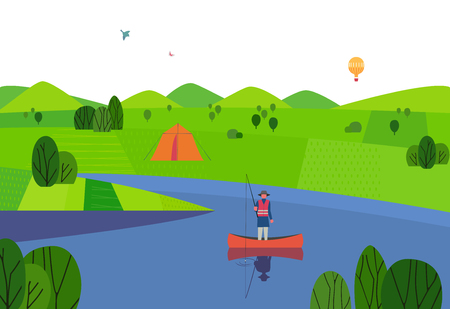1. Understanding the Zero-Waste Philosophy
Zero-waste camping is more than just a trend—its a mindset shift that encourages outdoor lovers to minimize their impact on nature. At its core, the zero-waste philosophy aims to send as little trash to landfills as possible by rethinking how we consume, reuse, and dispose of materials. For campers, this means planning trips with intention, choosing sustainable gear, and embracing habits that leave no trace behind.
What Does “Zero-Waste” Really Mean?
In simple terms, zero-waste means reducing what you throw away to near zero. It’s about making eco-friendly choices before, during, and after your camping trip. That could mean packing reusable containers instead of single-use plastics or choosing biodegradable soap over chemical-laden cleaners.
Why Zero-Waste Matters in the Outdoors
Nature isnt equipped to handle our trash. Even biodegradable items like food scraps can disrupt ecosystems or attract wildlife in harmful ways. Campgrounds and backcountry sites often lack proper waste disposal options, so it’s crucial that we pack out everything we bring in. By adopting zero-waste habits, campers help preserve wild spaces for future generations.
The Five Rs of Zero-Waste Camping
A helpful way to understand the zero-waste approach is through the “Five R’s.” Heres a breakdown of how they apply to camping:
| R Principle | How It Applies to Camping |
|---|---|
| Refuse | Say no to single-use items like plastic utensils, straws, and packaged snacks. |
| Reduce | Minimize what you bring—only pack what you truly need. |
| Reuse | Opt for durable gear and containers that can be used again and again. |
| Recycle | If you must use disposables, choose recyclable materials and take them home to recycle properly. |
| Rot | Compost food scraps when possible; if not, pack them out. |
Cultivating a Mindful Camping Mindset
The journey toward zero-waste starts with awareness. Before hitting the trail or setting up camp, take time to consider each item you pack—where it comes from, how it will be used, and where it will end up. With a little mindfulness and preparation, every camper can become a better steward of the environment.
2. Planning Your Trip the Sustainable Way
Heading out on a zero-waste camping trip starts long before you set foot in nature. With a little planning, you can cut down on waste, reduce your carbon footprint, and still enjoy all the best parts of outdoor living. This section walks you through sustainable ways to prepare for your adventure—from packing smart to choosing eco-friendly products and getting there responsibly.
Smart Packing: What to Bring (and What to Leave Behind)
The key to zero-waste camping is intentional packing. Focus on reusable items and avoid anything single-use whenever possible. Heres a handy table to guide your packing:
| Item Type | Zero-Waste Option | Avoid |
|---|---|---|
| Food Storage | Stainless steel containers, beeswax wraps, silicone bags | Plastic wrap, disposable zip bags |
| Eating Utensils | Bamboo or metal utensils, reusable plates and cups | Plastic forks, paper plates |
| Cleaning Supplies | Biodegradable soap, reusable dishcloths | Scented wet wipes, paper towels |
| Beverages | Refillable water bottles, thermos for hot drinks | Bottled water, canned drinks |
Meal Prepping: Reduce Waste Before You Go
A little meal prep goes a long way in cutting down packaging waste at the campsite. Plan meals ahead of time using bulk ingredients or items from local farmers markets. Pre-chop veggies and portion out meals into reusable containers. Avoid bringing anything that generates trash like individually packaged snacks or single-serve condiments.
Tasty and Low-Waste Meal Ideas:
- Mason jar overnight oats with dried fruit and seeds
- Pasta salad prepped in silicone containers
- Tin foil packet meals using local veggies (reuse foil if possible!)
Selecting Eco-Friendly Gear
If youre in the market for new gear, choose durable products made from sustainable materials. Look for brands that use recycled fabrics or offer lifetime warranties. Renting or borrowing gear is another great option—especially if you’re a beginner camper or only go occasionally.
Sustainable Gear Tips:
- Tents made from recycled polyester or organic cotton
- Solar-powered lanterns and chargers
- Synthetic-free sleeping bags filled with natural fibers like wool or down (ethically sourced)
Sustainable Transportation Options
Your journey to the campsite matters just as much as what you do once you get there. If possible, carpool with friends to reduce emissions or use public transportation options that get you close to your destination. For nearby sites, consider biking or hiking in if its safe and feasible.
Clever Travel Tips:
- Create a carpool group with fellow campers using rideshare apps or social media groups
- Select campgrounds accessible via train or bus routes when available
- If driving solo is your only option, offset your carbon footprint through verified carbon credit programs
The more thoughtfully you plan your trip, the easier it becomes to keep waste at bay while enjoying nature responsibly. By packing smart, prepping food wisely, choosing ethical gear, and traveling mindfully—you’re already making a big difference.

3. Leave No Trace: Zero-Waste Practices at the Campsite
Camping is all about connecting with nature—but it’s also our responsibility to protect it. By adopting zero-waste habits at your campsite, you can help preserve wild spaces for future adventurers. Here’s how to minimize your impact while still enjoying a comfortable and fun outdoor experience.
Choose Reusables Over Disposables
One of the easiest ways to reduce waste is by packing reusable gear. Say goodbye to single-use plastics and hello to durable, eco-friendly alternatives. Heres a quick comparison:
| Single-Use Item | Zero-Waste Alternative |
|---|---|
| Plastic utensils | Bamboo or stainless steel cutlery set |
| Paper plates | Reusable camping dishware (metal, silicone, or enamel) |
| Plastic water bottles | Refillable stainless steel or BPA-free bottles |
| Ziploc bags | Silicone food storage bags or beeswax wraps |
| Paper towels | Washable cloth rags or microfiber towels |
Set Up a Waste Sorting System at Camp
A simple sorting system helps you manage waste responsibly and makes clean-up easier. Use clearly labeled bags or bins for:
- Recyclables: Clean cans, plastic containers, paper, etc.
- Compost: Fruit peels, coffee grounds, biodegradable food scraps (if allowed in the area)
- Trash: Items that can’t be reused or recycled
Pro Tip:
If youre camping in bear country, store all food waste and scented items in bear-proof containers or hang them safely away from your tent.
Sustainable Hygiene Practices
Your hygiene routine doesn’t have to come at nature’s expense. Here are some low-impact options:
- Biodegradable soap: Always use it at least 200 feet away from any water source.
- Reusable cloth wipes: Washable wipes reduce the need for disposable ones.
- Menstrual products: Consider menstrual cups or reusable pads as sustainable alternatives.
- Trowel & toilet kit: For backcountry trips, pack a lightweight trowel to dig catholes for human waste where permitted.
Campsite Cooking Without the Trash
You don’t need pre-packaged meals to enjoy great camp food. Try these strategies instead:
- Pre-prep meals at home: Store ingredients in reusable containers to avoid packaging waste on-site.
- Avoid single-serving snacks: Buy in bulk and portion out into reusable snack bags.
- Use a portable stove: Less impact than building fires and more controlled cooking.
Packing Out: Take Everything With You
The golden rule of zero-waste camping is: if you pack it in, pack it out. This includes all trash, leftover food, hygiene products, and even micro-trash like twist ties or bottle caps. Before leaving your site, do a final sweep of the area—many campers call this a “Leave No Trace check.” Your goal is to make it look like no one was ever there.
Remember:
Your campsite is part of a shared natural space. Practicing zero-waste camping not only preserves its beauty but also sets an example for others to follow.
4. Eco-Friendly Cooking and Food Storage
Cooking in the great outdoors is one of the best parts of camping, but it can also create a lot of waste if youre not careful. By making a few mindful choices, you can enjoy delicious meals while keeping your environmental impact low.
Sustainable Cooking Gear
Start by choosing reusable and eco-friendly cooking equipment. Stainless steel, cast iron, and titanium cookware are durable alternatives to disposable pans or plastic utensils. Opt for bamboo or stainless steel cutlery, and bring along reusable plates and cups instead of single-use paper or plastic ones.
| Eco-Friendly Item | Why Its Better |
|---|---|
| Stainless Steel Cookware | Durable, easy to clean, and long-lasting |
| Bamboo Utensils | Biodegradable and lightweight |
| Reusable Dishware | Reduces trash and saves money over time |
Locally-Sourced Ingredients
Support local farmers and reduce your carbon footprint by purchasing fresh produce from nearby markets before heading out. Not only does this support small businesses, but it also cuts down on packaging waste and transportation emissions.
Quick Tips for Local Shopping:
- Visit farmers markets near your home or campground.
- Bring your own containers or cloth bags to avoid plastic packaging.
- Choose seasonal fruits and veggies for better flavor and sustainability.
Zero-Waste Meal Prep Ideas
Prepping your meals ahead of time can help reduce food waste and make cooking at the campsite easier. Chop veggies at home and store them in reusable silicone bags or glass containers. Cook grains or pasta in bulk and portion them into containers ready to heat up over the campfire.
Smart Food Storage Without Single-Use Plastics
Avoid zip-top bags, cling wrap, or styrofoam coolers. Instead, go for sustainable storage solutions that are made to last.
| Storage Option | Sustainable Benefit |
|---|---|
| Silicone Food Bags | Washable, leak-proof, and freezer-safe |
| Mason Jars | Perfect for storing sauces, snacks, or dry goods |
| Cotton Beeswax Wraps | A natural alternative to plastic wrap for covering food items |
| Hard-Shell Coolers (non-styrofoam) | Long-lasting and keeps food cold without wasteful ice packs |
Managing Leftovers Responsibly
No one wants to waste food—especially not when youre out in nature. Pack any leftovers into airtight containers as soon as possible and keep them cool in your cooler. For perishable items, eat them within a day or two to avoid spoilage. If you have access to composting facilities at your campsite or plan to bring scraps home, separate compostable materials like veggie peels or eggshells in a sealed container.
Compost-Friendly Scraps:
- Fruit & veggie peels
- Coffee grounds & tea leaves (without synthetic bags)
- Bread crumbs & grains (in moderation)
- Eggshells (crushed)
By combining smart gear choices with local ingredients and proper storage methods, you’ll master zero-waste cooking in no time—and help protect the beautiful places you love to explore.
5. Cleaning Up: Waste Management and Pack-Out Tips
When it comes to zero-waste camping, how you handle your trash can make or break your eco-friendly goals. Keeping the wilderness clean isn’t just about being tidy—it’s about preserving nature for everyone who comes after you. Here’s how to responsibly manage waste during and after your trip.
Sort Your Waste Like a Pro
Before heading out, bring bags or containers for separating waste. This makes it easier to pack out and dispose of properly when you get home or reach a recycling station.
Recommended Sorting System:
| Category | Examples | What to Do With It |
|---|---|---|
| Recyclables | Cans, bottles, cardboard | Rinse and store separately to recycle at home or nearest facility |
| Compostables | Fruit peels, coffee grounds | Store in sealed container; compost at home if possible |
| Trash | Plastic wrappers, dirty napkins | Pack out in a sturdy bag; dispose of properly after your trip |
Managing Gray Water Responsibly
Gray water—used water from washing dishes or brushing teeth—can harm local ecosystems if not handled correctly. Follow Leave No Trace principles when disposing of it:
- Use biodegradable soap: Make sure it’s labeled safe for outdoor use.
- Strain food scraps: Use a mesh strainer to catch solids before dumping water.
- Bury gray water: At least 200 feet away from water sources and trails, dig a small hole (a “cat hole”) and pour in strained water.
No Trash Left Behind: Pack It All Out
The golden rule of zero-waste camping is simple: If you packed it in, pack it out. Always do a final sweep of your campsite before leaving. Bring extra bags just in case—you may even find litter left by less-careful campers that you can help remove.
Pro Tip:
Airtight containers or odor-proof bags are great for storing trash until you can dispose of it properly. This helps avoid attracting wildlife and keeps your gear clean.
Quick Checklist Before You Leave:
- [ ] All recyclables sorted and stored
- [ ] Compostable items sealed up for home composting
- [ ] All trash packed out securely
- [ ] Campsite checked for micro-trash (twist ties, bread tags, etc.)
- [ ] Gray water disposed of following Leave No Trace guidelines
With the right mindset and a little preparation, managing waste on your camping trip doesn’t have to be hard. Plus, youll feel great knowing youre doing your part to protect the environment!


